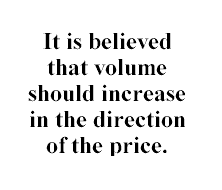It is believed that volume should increase in the direction of the price. If the prevailing trend is up, volume should be heavier on the up days and lighter on the the down days. If the trend was down, volume should be heavier on the down days, with ligh ter volume on the up days. This makes sense because in an uptrend there should be more buyers than sellers, and in a downtrend there should be more sellers than buyers. If volume should start to diminish, it could be a warning that the trend could be losing steam and that a consolidation or perhaps a reversal could be ahead. If the trend was up, and now we're seeing more volume on dips than on rallies, it should be an alert that buying pressure is waning and sellers are becoming more aggressive. The reverse would be true in a downtrend. If volume starts to shrink on the sell-offs and picks up on the rallies, once again, it could be a sign that the trend is in trouble, and buyers are starting to assert themselves. When volume moves in the opposite direction of the price, this is called divergence.
ter volume on the up days. This makes sense because in an uptrend there should be more buyers than sellers, and in a downtrend there should be more sellers than buyers. If volume should start to diminish, it could be a warning that the trend could be losing steam and that a consolidation or perhaps a reversal could be ahead. If the trend was up, and now we're seeing more volume on dips than on rallies, it should be an alert that buying pressure is waning and sellers are becoming more aggressive. The reverse would be true in a downtrend. If volume starts to shrink on the sell-offs and picks up on the rallies, once again, it could be a sign that the trend is in trouble, and buyers are starting to assert themselves. When volume moves in the opposite direction of the price, this is called divergence.
 ter volume on the up days. This makes sense because in an uptrend there should be more buyers than sellers, and in a downtrend there should be more sellers than buyers. If volume should start to diminish, it could be a warning that the trend could be losing steam and that a consolidation or perhaps a reversal could be ahead. If the trend was up, and now we're seeing more volume on dips than on rallies, it should be an alert that buying pressure is waning and sellers are becoming more aggressive. The reverse would be true in a downtrend. If volume starts to shrink on the sell-offs and picks up on the rallies, once again, it could be a sign that the trend is in trouble, and buyers are starting to assert themselves. When volume moves in the opposite direction of the price, this is called divergence.
ter volume on the up days. This makes sense because in an uptrend there should be more buyers than sellers, and in a downtrend there should be more sellers than buyers. If volume should start to diminish, it could be a warning that the trend could be losing steam and that a consolidation or perhaps a reversal could be ahead. If the trend was up, and now we're seeing more volume on dips than on rallies, it should be an alert that buying pressure is waning and sellers are becoming more aggressive. The reverse would be true in a downtrend. If volume starts to shrink on the sell-offs and picks up on the rallies, once again, it could be a sign that the trend is in trouble, and buyers are starting to assert themselves. When volume moves in the opposite direction of the price, this is called divergence.
One of the reasons why volume has a tendency to diminish during periods of indecision is for just that reason. During periods of sideways movement, often traders will avoid a market, preferring to commit their funds once a clear-cut breakout is seen. However, while it's typical for volume to diminish during these times, volume can give clues as to possible future direction by measuring the level of conviction of the buyers and the sellers. Seeing if there's heavier volume on the up days or on the down days could be useful in getting positioned during a sideways move or a formation of a pattern. The idea being that if there's more volume on the up days than the down days, the buyers are probably the more aggressive and the market should more than likely breakout to the upside. The reverse being true if the volume is heavier on the down days, with the market likely to breakout to the downside.
So while it seems as if chart patterns, volume and technical analysis in general all have some forecasting abilities, none are foolproof. Used together, they can be quite helpful in your trading and investing, but should be looked at more as helpful hints as to a markets bias, more than anything else.
No comments:
Post a Comment